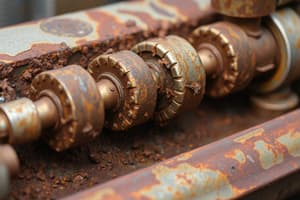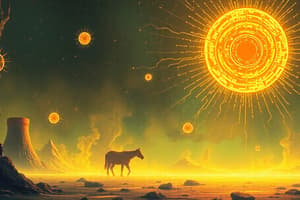Podcast
Questions and Answers
What is the dependent variable in the study measuring jump height?
What is the dependent variable in the study measuring jump height?
- Group assignment
- Jump height (correct)
- Duration of exercise
- Type of treatment
Which energy system is considered the fastest for ATP production?
Which energy system is considered the fastest for ATP production?
- Oxidation of CHO
- Phosphagen (correct)
- Slow Glycolysis
- Fast Glycolysis
Which system yields the least ATP production capacity?
Which system yields the least ATP production capacity?
- Slow Glycolysis
- Fast Glycolysis
- Oxidation of Fat and Protein (correct)
- Phosphagen
Which of the following bonds is formed when two atoms share electrons?
Which of the following bonds is formed when two atoms share electrons?
Which of the following organic compounds is NOT classified as a carbohydrate?
Which of the following organic compounds is NOT classified as a carbohydrate?
What is the primary function of DNA in cells?
What is the primary function of DNA in cells?
How many sugars are considered in polysaccharides?
How many sugars are considered in polysaccharides?
Which substance is generated when ATP is broken down during energy release?
Which substance is generated when ATP is broken down during energy release?
Rank the following ATP production systems from fastest to slowest: Phosphagen, Fast Glycolysis, Slow Glycolysis, Oxidation of CHO, Oxidation of Fat and Protein.
Rank the following ATP production systems from fastest to slowest: Phosphagen, Fast Glycolysis, Slow Glycolysis, Oxidation of CHO, Oxidation of Fat and Protein.
What role do the independent and dependent variables play in a study measuring jump height?
What role do the independent and dependent variables play in a study measuring jump height?
Explain the difference between ionic and covalent bonds.
Explain the difference between ionic and covalent bonds.
What is the primary energy molecule generated in the breakdown of ATP?
What is the primary energy molecule generated in the breakdown of ATP?
List the two types of nucleic acids and their primary functions.
List the two types of nucleic acids and their primary functions.
What type of organic compound is glycogen, and what is its primary function?
What type of organic compound is glycogen, and what is its primary function?
Identify and describe the main byproducts produced during vertical jumps.
Identify and describe the main byproducts produced during vertical jumps.
Which energy system has the highest ATP production capacity?
Which energy system has the highest ATP production capacity?
Differentiate between organic and inorganic compounds with examples.
Differentiate between organic and inorganic compounds with examples.
What is the function of the cardiovascular system in relation to muscular performance?
What is the function of the cardiovascular system in relation to muscular performance?
Flashcards are hidden until you start studying
Study Notes
Exam 1 Review
- Dependent variable: The outcome being measured.
- Independent variable: The factor being manipulated or changed, such as treatment, time, or group.
- Population: The group being studied, in this case, 18 participants.
Energy Systems
- Creatine Phosphate: Fastest energy system, providing ATP quickly but with limited capacity.
- Glycolysis: Two phases: Fast and slow. Fast glycolysis produces ATP quickly but less efficiently than slow glycolysis.
- Mitochondrial ATP Generation: Slowest energy system but yields the most ATP, using primarily carbohydrates, fat, and protein.
- System Rank (Fastest to Slowest):
- Phosphagen: Fastest
- Fast Glycolysis: Second fastest
- Slow Glycolysis: Third fastest
- Oxidation of Carbohydrates: Fourth fastest
- Oxidation of Fat and Protein: Slowest
- ATP Yield:
- Oxidation of Carbohydrates: Yields the most ATP.
Chemical Bonds
- Ionic bonds: Form when atoms transfer electrons, resulting in oppositely charged ions that attract.
- Covalent bonds: Form when atoms share electrons, resulting in a stable molecule.
Organic Compounds
- Carbohydrates: Composed of carbon, hydrogen, and oxygen.
- Monosaccharides: Simple sugars (glucose, fructose).
- Disaccharides: Two monosaccharides linked together (sucrose, lactose).
- Polysaccharides: Complex carbohydrates made up of many monosaccharides (cellulose, glycogen, starch).
- Proteins: Made up of amino acids joined together by peptide bonds.
- Lipids: Includes fats, oils, waxes, and steroids.
- Phospholipids: Important components of cell membranes.
- Sterols: Include cholesterol, which is essential for cell function.
- Triglycerides: Provide energy storage.
- Nucleic Acids: Store and transmit genetic information.
- DNA (deoxyribonucleic acid): Contains genetic instructions.
- RNA (ribonucleic acid): Translates genetic information from DNA to create proteins.
- ATP (adenosine triphosphate): A specialized nucleic acid that stores and releases energy.
Inorganic Compounds
- Water (H2O): Essential for life, involved in many bodily functions.
- Oxygen (O2): Used by cells for energy production.
- Carbon dioxide (CO2): A waste product of cellular respiration.
- Salts: Electrolytes that play vital roles in maintaining fluid balance and nerve function.
Polysaccharides
- Cellulose: Found in plant cell walls, indigestible by humans.
- Glycogen: The storage form of glucose in animals, found primarily in the liver and muscles.
- Starch: The storage form of glucose in plants.
Molecules and Compounds
- Molecule: Formed when two or more of the same element are combined.
- Compound: Formed when two or more different elements are combined.
Nucleic Acids
- DNA: Stores genetic information as a double helix structure, with each strand containing a sequence of nucleotides.
- RNA: A single-stranded nucleic acid that plays a key role in protein synthesis.
ATP
- Adenosine Triphosphate (ATP): The primary energy currency of the cell, released by breaking the bond between the second and third phosphate groups.
- Adenosine Diphosphate (ADP): Formed when ATP loses a phosphate group, releasing energy.
Dependent and Independent Variables
- Dependent Variable: The outcome measurement being studied.
- Independent Variable: The factor that is manipulated or changed in an experiment (e.g., treatment, time, or group).
Time, Pre and Post
- The data may be collected before and after a specific intervention.
Exam Format
- 60 minutes to complete exam.
- 1 minute per multiple choice question, 2 minutes for fill-in-the-blank.
Study Example
- Population: 18 participants
- Independent Variable: Different experimental conditions
- Dependent Variable: Jump height
- Control Group: Performed a neutral test.
- Experimental Group: Performance measured when combining aF and EF conditions.
Energy Systems
- Creatine Phosphate: Provides immediate energy for short bursts of activity.
- Glycolysis: Breaks down glucose to produce ATP, providing energy for moderate-intensity exercise.
- Mitochondrial ATP Generation: The process of converting food into ATP, providing sustained energy for prolonged activity.
Energy System Ranking
- Fastest/Greatest ATP Production: Phosphagen System
- Second Fastest: Fast Glycolysis
- Third Fastest: Slow Glycolysis
- Fourth Fastest: Oxidation of Carbohydrates
- Slowest/Least ATP Production: Oxidation of Fat and Protein
ATP Yield
- Highest Yield: Oxidation of Fat and Protein
- Second Highest: Oxidation of Carbohydrates
- Third Highest: Slow Glycolysis
Energy Systems and Exercise
- Phosphagen System: Used for activities lasting 10 seconds or less.
- Glycolysis: Used for activities lasting 30 seconds to 2 minutes (high intensity).
- Oxidative System: Used for activities lasting longer than 2 minutes (low to moderate intensity).
Body Systems
- Muscular System: Responsible for movement.
- Cardiovascular System: Transports oxygen and nutrients to the muscles.
- Skeletal System: Provides structure and support for the body.
Chemical Bonds
- Ionic Bonds: Form when atoms transfer electrons, resulting in positively and negatively charged ions that attract each other.
- Covalent Bonds: Form when atoms share electrons.
Organic Compounds
- Carbohydrates: Provide energy, including monosaccharides (simple sugars), disaccharides, and polysaccharides (complex sugars).
- Proteins: Building blocks of the body, composed of amino acids.
- Lipids: Energy storage and insulation, including phospholipids, sterols, and triglycerides.
- Nucleic Acids: Carry genetic information, including DNA and RNA.
- DNA: Deoxyribonucleic acid; contains genes that determine amino acid production and stores genetic information.
- RNA: Ribonucleic acid; translates DNA code into amino acid production.
- ATP: Adenosine Triphosphate; specialized nucleic acid that is the primary energy currency of the cell.
Inorganic Compounds
- Water: The universal solvent and essential for life.
- Oxygen: Necessary for cellular respiration.
- Carbon Dioxide: A waste product of cellular respiration.
- Salts: Provide electrolytes (minerals that carry electrical charges).
Polysaccharides
- Cellulose: A complex carbohydrate found in plant cell walls; cannot be digested by humans.
- Glycogen: The storage form of glucose in animals.
- Starch: The storage form of glucose in plants.
Molecules and Compounds
- Molecule: Same elements combined together.
- Compound: Two or more different elements ions joined together.
Key Notes about Nucleic Acids, DNA and RNA
- DNA: Deoxyribonucleic acid - Carries genetic information.
- RNA: Ribonucleic acid - Translates DNA code into amino acid production.
ATP: Energy Currency of the Cell
- ATP (Adenosine Triphosphate): The primary energy currency of the cell, providing energy for cellular work.
- ADP (Adenosine Diphosphate): Created when ATP breaks down, releasing energy.
Studying That Suits You
Use AI to generate personalized quizzes and flashcards to suit your learning preferences.





